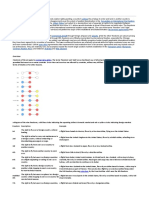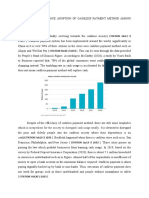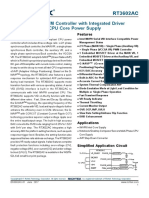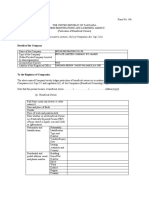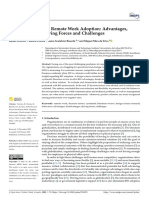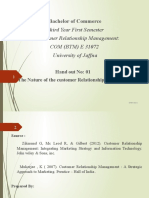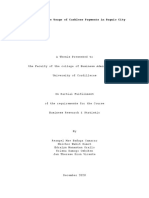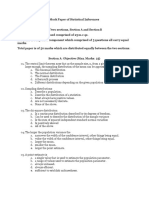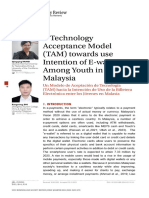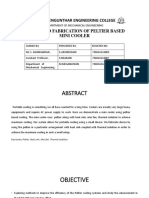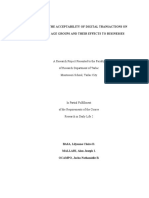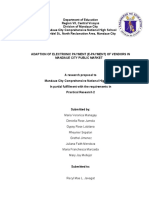Factors Influencing Cashless Payment Adoption of Microenterprises in Baguio City
Factors Influencing Cashless Payment Adoption of Microenterprises in Baguio City
Volume 10, Issue 2, February – 2025 International Journal of Innovative Science and Research Technology
ISSN No:-2456-2165 https://doi.org/10.5281/zenodo.14979629
Factors Influencing Cashless Payment Adoption of
Microenterprises in Baguio City
Jeanette Y. Bal-iyang1
1
Master in Business Administration University of the Cordilleras Baguio City, Philippines, 2600
Publication Date: 2025/03/11
Abstract: This study was conducted to investigate the factors influencing the cashless payment adoption among
microenterprises in Baguio City to understand the current status of microenterprises, the level of influence of factors such
as Perceived Ease of Use, Perceived Usefulness, and Perceived Trust on adoption decisions, and identifying the challenges
faced by these microenterprises. A mixed method approach was used, with quantitative data gathered through surveys
while qualitative was applied to thematic analysis. The data analysis included descriptive statistics and the Kruskal-Wallis
H Test with Dunn’s Test. The findings reveal that PEOU and PU greatly influence the decision to adopt cashless payments
while PT is important for ensuring successful implementation. Microenterprises show a significant level of awareness and
willingness to adopt cashless payments, despite this they face challenges such as technical errors and trust issues. The
study concludes that the capital of microenterprises ranges from PHP 100,000 to PHP 500,000, with mobile payments and
debit/credit cards being the most convenient and widely used methods. To overcome these challenges, the study
recommends providing training and support to microenterprises, improving cashless payment security, and working with
local government agencies and policymakers to create policies promoting cashless payments.
Keywords: Microenterprises, Cashless Payment, Perceived Ease of use, Perceived Usefulness, Perceived Trust
How to Cite: Jeanette Y. Bal-iyang. (2025). Factors Influencing Cashless Payment Adoption of Microenterprises in Baguio City.
International Journal of Innovative Science and Research Technology, 10(2), 1905-1913.
https://doi.org/10.5281/zenodo.14979629
I. INTRODUCTION In Baguio City, the Government and other
organizations are trying to encourage more businesses to
Microenterprises are small businesses with less than 10 adopt cashless payments. They even have programs like
employees and with limited assets. In the Philippines, these “Paleng-QR PH” program that make it easier for market
small businesses are really important because they help the vendors to accept payments through QR code which you can
local economy by providing jobs and supporting other local scan with your phone to pay (Domingo, R., 2022). Despite
businesses (Yabut, H., n.d.). Think about how people pay for governmental initiatives the microenterprises in Baguio City
things they bought in your store. Traditionally, most face significant challenges in adopting cashless payments.
payments are made with cash. But with technology
advancing there is a push towards using digital methods like This study looks at why some businesses are hesitant to
paying with a mobile phone or a card and this is what we call adopt cashless payment and what can be done to encourage
“Cashless Payments” that make transactions quicker, safer, them. By understanding these reasons we can help small
and easier to track (Dotong, E., 2019). However, not business grow and make the economy stronger, especially as
everyone is using these cashless methods yet, and there are a the world moves more towards digital solutions (Ozkan et al.,
few reasons for this like not everyone has good internet 2010).
connections (World Bank, 2020) or some people don’t trust
digital payments (Özkan, Bindusara and Hackney, 2010). But The researcher used the Technology Acceptance Model
during the Covid-19 pandemic it became clear that cashless (TAM) as the basis for conducting the research. This includes
payments are really useful because it reduced the need for understanding the extent to which these microenterprises
physical contact which is safer for everyone (Regalado, F., have integrated cashless payment into their transactions.
2020). TAM is a theoretical framework that explains how users
come to accept and use technology (Davis, F. D., 1989).
IJISRT25FEB1424 www.ijisrt.com 1905
Volume 10, Issue 2, February – 2025 International Journal of Innovative Science and Research Technology
ISSN No:-2456-2165 https://doi.org/10.5281/zenodo.14979629
Fig 1 The Technology Acceptance Model (TAM)
Statement of the Problems/Objectives gathering tool, the data gathering procedure, and the
This study aims to investigate the cashless payment treatment of data.
adoption of microenterprises in Baguio City. Specifically, it
sought to answer the following Questions: Research Design and Methodology
The researcher used mixed method combining
What is the current status of microenterprises in Baguio quantitative and qualitative approach to explore the
City according to: relationship between cashless payments and various factors,
and to understand how these factors influence payment
Business Capital; options. By this, for example, interviews tend to be more
Awareness; and qualitative and surveys tend to be more quantitative
Business Performance? (Creswell & Plano Clark, 2007).
What is the level of influence of the following factors to Population and Locale of the Study
owners of microenterprises in Baguio City decision to
adopt cashless payment transaction in terms of: The researcher used purposive sampling a non-
probability sample in which the participants are chosen based
Perceived Ease of Use; on specific characteristics of the population and the
Perceived Usefulness; and objectives of the study (Crossman, A., 2022) to select
Perceived Trust? participants based on their willingness to partake in the study.
The participants are the microenterprises owners or the
Is there a significant difference on the level of influence assistants/associates who oversee the day-to-day operations
of the factors to owners of microenterprises in Baguio of the business within Baguio Public Market and Mines View
City decision to adopt cashless payment transactions if Park involving those who are using cashless payment
grouped according to: methods like Debit/Credit card, Mobile Payment, Online
Banking, and other payments that don’t use paper money and
Business Capital; coins. They were chosen by the researcher since they are the
Awareness; and ones who fit the study in a relatively small sample with a
Business Performance? high concentration of microenterprises and wide range of
goods and services, giving a comprehensive understanding of
Ha = There is a significant difference on the level of the adoption of cashless payment in these specific
influence of the factors on owners of microenterprises of marketplaces.
Baguio City decision to adopt cashless payment transactions
between Business Capital, Awareness, Business Data Gathering Tools
Performance, and PEOU, PU, and PT To gather data for the study survey questionnaire was
used based on the research objectives and conceptual
framework. A survey questionnaire consists of a structured
What are the problems/challenges the owners of
set of questions carefully designed to be answered by a group
microenterprises in Baguio City faces that hinder them to
of people designed to collect relevant facts and information
implement cashless payment?
(Preston V., 2009). The research instrument was divided into
three parts. The first part focused on the current status of
II. DESIGN AND METHODOLOGY
microenterprises in Baguio City, specifically in the Baguio
Public Market and Mines View Park. The second part
The methodology presents the design that will be used
focused on the respondents' level of acceptance of the
in the study, the population and locale of the study, the data
IJISRT25FEB1424 www.ijisrt.com 1906
Volume 10, Issue 2, February – 2025 International Journal of Innovative Science and Research Technology
ISSN No:-2456-2165 https://doi.org/10.5281/zenodo.14979629
Technology Acceptance Model's factors (TAM), and the items are actually measuring the constructs they are supposed
third part highlighted problems and challenges faced by to measure we used exploratory factor analysis.
owners of microenterprises in Baguio City that hinder them
from implementing cashless payment. To answer the third question, the data was grouped into
categories based on predetermined criteria like business
Data Gathering Procedure capital, awareness and business performance. To check for
Prior to conducting the study, the questionnaire went differences in mean scores of perceived ease of use,
through pilot testing with a small group of respondents to usefulness and trust between groups, we employed statistical
identify any issues with the questions. Afterwards, the tests such as Kruskal-Wallis H Test. This was supported by
researcher wrote a request letter addressed to the Permits and the test of normality that resulted in P>0.001 showing that
Licensing Division of Baguio City together with the attached the data is not normally distributed. The Kruskal-Wallis H
approved questionnaire to obtain the lists of registered Test, a statistical test used to determine whether there are
microenterprises in the Baguio Public Market and Mines significant differences between the medians of three or more
View Park for the year 2023. Moreover, a reliability analysis independent groups. It is a non-parametric test (McClengan,
using Cronbach’s Alpha of internal consistency was E., 2023). The researcher also used Dunn’s Test to conduct a
conducted to a total of 15 items in the survey to determine post hoc comparison of the significant results from the
the strength of the questionnaire for the sample, and the result Kruskal-Wallis H Test to identify which groups differ
shows a high level of internal consistency with a value of (Dinno, A., 2015).
0.908 which means the survey is very reliable.
To answer the fourth question, thematic analysis was
The data collected for this study were analyzed using a used in an essay written by participants to identify challenges
combination of quantitative and qualitative methods. that hinders the implementation of cashless payment. Then,
Descriptive statistics were calculated for Likert scale items to the researcher discussed these challenges again and looked
understand the distribution of responses, from 1 to 4, with 1 for potential solutions or responses.
indicating “Strongly Disagree” and 4 indicating “Strongly
Agree”, including the mean, median, and standard deviation. III. PRESENTATION, ANALYSIS AND
INTERPRETATION OF DATA
Qualitative data, such as an interview response can be
gathered through exploratory or descriptive survey questions, This confers the results and discussion, particularly on
then transcribed and coded using thematic analysis. This the analysis of the factors influencing the adoption of
analysis identified common themes and patterns related to the cashless payment by microenterprises in Baguio City. It
factors influencing the adoption of cashless payment among examines their current status with respect to business capital,
microenterprises in Baguio City. awareness, and business performance. Thereafter, it explores
the level of influence of perceived ease of use, perceived
The findings from both the quantitative and qualitative usefulness, and perceived trust on the decision to adopt
analysis were integrated to provide a comprehensive cashless payment. Additionally, this chapter investigates
understanding of the factors influencing adoption of cashless whether there are significant differences that exist in these
payment. The quantitative findings highlighted specific levels of influences when microenterprise owners are
perceptions and attitudes of microenterprises towards grouped according to business capital, awareness, and
cashless payment adoption, while the qualitative findings business performance. Moreover, it identifies the challenges
provided deeper insights into the underlying reasons and and problems faced by microenterprise owners that hinder
motivations behind these perceptions. This integrated them from implementing cashless payment. Furthermore, it
approach allowed for a nuanced understanding of the factors comprises the discussion, interpretations, and corroborations
influencing cashless payment adoption by microenterprises in of the findings. This also provides comprehensions and
Baguio City, providing valuable insights for policymakers recommendations for improving the adoption of cashless
and stakeholders. payments in the context of microenterprises.
Treatment of Data Current Status of Microenterprises in Baguio City
To answer the first question, the researcher utilized
descriptive statistical methods to categorize the data. The Business Capital: In terms of business capital, it shows
techniques employed included mean, median, and mode to that most microenterprise owners have a capital ranging
illustrate the distribution for each component to analyze from PHP 100,000.00 to PHP 500,000.00 (M= 2.0255).
current status of microenterprises in Baguio City.
Awareness: Based on the results there is a high level of
To answer the second question in measuring the level Familiarity with cashless payment methods with (Mean:
of influence of factors on the adoption of cashless payment 1.3758), and this suggests that most business and
transactions among microenterprise owners in Baguio City, a consumers are familiar with and frequently use cashless
detailed questionnaire was created. The researcher conducted payments. Similarly, based on the results there is a high
a descriptive statistical method to assess the level of level of Satisfaction with cashless payment methods they
influence of Perceived Ease of Use, Perceived Usefulness, are currently offering with (Mean: 1.3503), and this
and Perceived Trust by calculating the mean and standard suggests that respondents are generally satisfied with the
deviation for each item on the Likert scale. To ensure that the cashless payment methods they currently use and have a
positive attitude towards them. Meanwhile, based on the
IJISRT25FEB1424 www.ijisrt.com 1907
Volume 10, Issue 2, February – 2025 International Journal of Innovative Science and Research Technology
ISSN No:-2456-2165 https://doi.org/10.5281/zenodo.14979629
results the respondents are Very Likely to adopt more Toombs (2014) also noted that social media marketing when
cashless payment options in the next year with (MEAN: incorporated with cashless payments will substantially
1.0382). improve sales efficiency and customer interaction. Overall,
respondents think cashless payments are really useful and
Business Performance: Based on the results on the Cash beneficial.
Flow respondents generally view their cash flow
positively with (Mean: 1.3758). Also, Based on the results Perceived Trust: Based on the total in PT the respondents
on the Debt respondents have an even more positive view AGREE with I trust in the cashless payment system's
of their debt management with (Mean: 2.5732). Overall, ability to facilitate timely and reliable transactions for my
respondents maintain a positive outlook on both their cash business needs as the Highest Score: Confidence in timely
flow and debt situations. and reliable transactions (Mean: 2.9172), and this
suggests that microenterprises have a positive but
Level of Influence of the Following Factors on Owners of cautious approach to trusting cashless payments. It’s more
Microenterprises in Baguio City's Decision to Adopt of a moderate level of trust than a very strong one. This is
Cashless Payment Transaction reflected in the studies of Özkan et al. (2010) highlighting
the importance of perceived trust and security in the
Perceived Ease of Use: Based on the total in PEOU the adoption of e-payment systems.
respondents STRONGLY AGREE with Using cashless
payments in my business would provide flexibility in While I have trust in the reliability of the cashless
interacting with customers as the Highest Score: payment service provider to ensure the security and integrity
Flexibility (Mean: 3.6115), and this suggests that of my business transactions as the Lowest Score: Confidence
microenterprises value how easy and adaptable these in security measures and confidentiality (Mean: 2.8408). This
systems are for selling products. The strong agreement is was emphasized by the findings of Riquelme & Rios (2010)
also reflected in Carter and Belanger's (2005) findings on the importance of trust in mobile banking services where
from e-government services and also Pavlou's (2003) the service provider’s security and reliability measures are
findings on online shopping flexibility and convenience in pivotal for adoption, and also on the study of Shinozaki &
user adoption. Rao (2021), highlighting the importance of security and
reliability of cashless payment systems during the pandemic.
While Cashless payment would be easy to use in selling A similar study by Nair (2016) discusses the challenges of
products as the Lowest Score: Ease of use in selling products cashless transactions in the Philippines particularly, the
(Mean: 3.4650), and this suggests that cashless payments are reliability of service providers. The lowest score suggests that
generally seen as easy to use, but there’s room for there are still some concerns about the reliability of cashless
improvement. This is reflected in the studies of Riquelme and payment service providers, especially when it comes to
Rios (2010), where ease of use is a critical factor for the security and confidentiality. Overall, respondents have a
adoption of mobile services, Park (2009), where users are positive view of cashless payments, but they don’t trust them
more likely to adopt cashless payments and if they find it completely. They are cautious rather than fully confident.
easy to use on e-learning platforms, and Weijters et. al. This means they see some benefits, but they're still careful
(2007) where customer-facing technology needs to be user about it.
friendly to encourage adoption. Overall, respondents have a
strong and positive view of cashless payments. Key Drivers of Cashless Payment Adoption
Perceived Usefulness: Based on the total in PU the According to Business Capital: In summary, based on the
respondents STRONGLY AGREE with Cashless statistical tests conducted, we don’t find substantial
payment would improve my business performance when differences in perceived ease of use, usefulness, or trust
customers purchase goods as the Highest Score: across various business capital categories, and this
Improvement in business performance (Mean: 3.6624), suggests that Business Capital has no effect on the factors
and this suggests that microenterprises see cashless mentioned. Dotong (2019), in the analysis of consumer
payments as very useful and beneficial for their satisfaction in the supermarkets of the Philippines,
businesses. This is supported by the study of Riquelme & indicates a positive perception of a cashless payment
Rios (2010) on mobile banking services, and also system regardless of the business’s financial capacity.
Gangwar et al. (2015) study on cloud computing services. Similar study of Shinozaki and Rao (2021), on the impact
In addition, Pavlou (2003) showed that the ease of of COVID-19 on MSME show that there is a similar
completing online transactions is considerably due to the perception of cashless payment irrespective of business
increase in customer satisfaction and repeat purchases. size.
While Cashless payment enhances my effectiveness in According to Awareness: In summary, the results suggest
selling goods as the Lowest Score: Effectiveness in selling that perceived ease of use and perceived usefulness
goods (Mean: 3.5350), and this suggests that cashless significantly impact acceptance of cashless payments,
payments help improve sales processes, making transactions while perceived trust does not. According to Zoleta
smoother and more efficient. This was highlighted by (2021), user familiarity with mobile wallet apps can
Weijters et al. (2007) on self-service checkout systems often significantly increase adoption. Nair (2016) and
featuring cashless payments enabling customers to complete Shinozaki and Rao (2021) emphasized the need to
transactions quickly and effectively. Similarly, Taneja &
IJISRT25FEB1424 www.ijisrt.com 1908
Volume 10, Issue 2, February – 2025 International Journal of Innovative Science and Research Technology
ISSN No:-2456-2165 https://doi.org/10.5281/zenodo.14979629
increase awareness and knowledge to improve the user Cloud Computing Services (Gangwar et al., 2015), and
experience. Social Media Marketing (Taneja & Toombs, 2014).
Therefore, Familiarity with Cashless Payments correlates
For PEOU, familiarity with cashless payment options with a higher PU.
significantly impacts acceptance. This result is also similar to
a study on mobile banking services (Riquelme & Rios, 2010), Meanwhile, for PU and Likelihood of increased
E-government services adoption (Carter & Bélanger, 2005), acceptance of cashless payments significantly impacts
E-learning platform adoption (Park, S. Y., 2009), and online acceptance. Some studies explore the likelihood of adopting
shopping adoption (Pavlou, P. A., 2003). It all leads to the cashless payment through its usefulness, Khando et al. (2023)
fact that being familiar with a specific technology or service in their Swedish study that convenience, cost, trust, risks,
is an important factor in influencing PEOU, with higher norms, and customer preference highlight that PU is a
levels of familiarity correlating to a positive PEOU. significant factor in adoption decisions. Raj et al. (2024)
examined variables that affect the adoption of cashless
In terms of familiarity and PU with cashless payment payment transactions during COVID-19 showing that PU is
options significantly impacts acceptance. Dotong (2019) also an important predictor of consumer’s intention to use
highlighted the importance of awareness in encouraging cashless payments. This shows that once microenterprises are
acceptance rates. Similar situations in Online Learning somewhat likely to adopt cashless payment, it must be
systems where a significant difference between users who are maintained to make sure that they are constantly using it.
not familiar and those very familiar, they found that those Awareness also does not impact PT. Still, it must not be
who are familiar with online learning systems are more likely ignored because cashless payment services' reliability and
to find them more useful (Lee et al., 2009). Similar studies security can improve trust over time.
are observed as well in E-Health Services (Or et al., 2009),
Table 1 Influence of Awareness on PEOU, PU, and PT in Cashless Payments
TAM Awareness Sig. Decision
PEOU Familiarity with cashless payment options .000 Reject the null hypothesis
Satisfaction with cashless payment options currently offer .176 Retain the null hypothesis
Likeliness to increased acceptance of cashless payments .054 Retain the null hypothesis
PU Familiarity with cashless payment options .003 Reject the null Hypothesis
Satisfaction with cashless payment options currently offer .174 Retain the null hypothesis
Likeliness to increased acceptance of cashless payments .028 Reject the null Hypothesis
PT Familiarity with cashless payment options .519 Retain the null Hypothesis
Satisfaction with cashless payment options currently offer .901 Retain the null hypothesis
Likeliness to increased acceptance of cashless payments .488 Retain the null hypothesis
According to Business Performance: Cash Flow- The Ease of Use (p = 0.006, adjusted p=0.018). However, there
result indicates that microenterprises with different levels was no significant difference between Poor and Good
of cash flow PEOU and PU differently. Cash flow may (p=0.917, adjusted p=1) and Poor and Excellent (p=0.432,
influence adoption of cashless payment systems such that adjusted p=1). The comparison further strengthens our
microenterprises with better cash flow may see cashless finding that usually those who have access to financial
payment easier to use and more useful given that they resources can easily adapt to cashless payment systems.
have better access to money and less concerns about any
constraints it may give. This makes it easier to use Debt- The lack of significance in PEOU, PU, and PT
cashless payment systems. This finding also with Khando shows that while cash flow is important, the level of debt-
et. al (2023) saw that PU is important in adoption related concerns don’t directly affect PEOU, PU, and PT. For
decisions. example, research on mobile payments (Kim et al., 2010)
shows that benefits and ease of use are crucial, while
Post hoc comparisons using Dunn’s method with a financial constraints do not always impact trust in
Bonferroni Correction for multiple tests indicate that there is technology. This highlights the consideration of financial
a significant difference between Good and Excellent for stability when checking the adoption of cashless payment
Business Performance in terms of Cash Flow in Perceived systems.
Table 2 Influence of Business Performance on PEOU, PU, and PT in Cashless Payments
TAM Business Performance Sig. Decision
PEOU The distribution of PEOU is the same across categories of Cash Flow .022 Reject the null hypothesis
The distribution of PEOU is the same across categories of Debt .151 Retain the null hypothesis
PU The distribution of PU is the same across categories of Cash Flow .043 Reject the null Hypothesis
The distribution of PU is the same across categories of Debt .297 Retain the null hypothesis
PT The distribution of PT is the same across categories of Cash Flow .125 Retain the null Hypothesis
The distribution of PT is the same across categories of Debt .517 Retain the null hypothesis
IJISRT25FEB1424 www.ijisrt.com 1909
Volume 10, Issue 2, February – 2025 International Journal of Innovative Science and Research Technology
ISSN No:-2456-2165 https://doi.org/10.5281/zenodo.14979629
Problems/challenges the owners of microenterprises in failure to receive confirmation compelled the need to
Baguio City faces that hinder them to implement cashless confirm transaction details to avoid mistakes and potential
payment errors. Some expressed concerns with regard to receiving
fake proof of payment because they failed to receive
In Baguio City, microenterprises have highlighted three confirmation. These issues are attributed to system errors,
main issues: Poor Connectivity and Network Problems technical glitches, and processing delays that is causing
inconvenience and reducing user confidence. Similarly,
Most of the respondents have highlighted problems some studies across Asia have observed problems and
with internet connectivity, whether it’s slow data signals, no challenges regarding the adoption of cashless payment.
signal or poor network connections. These setbacks have According to Susanto et al. (2022), they emphasize the
considerably hindered their ability to complete cashless importance of addressing these challenges as system errors
payment transactions without interruptions resulting in lack and processing delays have been major problems to the
of trust in cashless payment platforms. When transactions adoption of digital payments. Doing so is important for
fail or customers experience delays, it not only affects the increasing the reliability and trust of customer in mobile
businesses but also their ability to meet customer payment platforms.
expectations leading to lost sales and customer
dissatisfaction, which influence the general acceptance of IV. CONCLUSIONS AND RECCOMENDATIONS
cashless payment methods (Tay et al., 2022). Resolving
these problems is important in building trust and Conclusions
encouraging wider adoption of cashless payment among Based on the findings, the following are the
microenterprises in Baguio City. In the Philippines, conclusions of this research study:
microenterprises view cashless payment systems as less
trustworthy than the traditional cash transactions, making it Majority of the microenterprises owners have a capital
more difficult to encourage people to use cashless ranging from PHP 100,000 to PHP 500,000.
transactions (ADB, 2017). According to the report of The most commonly used cashless payment system are
International Telecommunication Union (ITU) on the issues Mobile payments (such as Gcash or PayMaya) and
related to internet connectivity being a significant barrier to debit/credit card and the main reason for its widespread
the adoption of cashless payments indicating that nearly half use is the convenience it offers which highlights the
of the world’s population doesn’t have access on reliable importance of ease of use.
internet, which is the most essential factor for trouble-free The current status of cashless payment adoption among
online transactions (ITU, 2021). microenterprises in Baguio City is influenced by factors
such as PEOU, PU, and PT in the cashless payment
System Maintenance and Downtime systems. With this regard, business owners are more
Another major issue is system maintenance and likely to adopt these systems if they find them helpful
downtime, many respondents mentioned both scheduled and and easy to use for their business operations while there
unscheduled maintenance that made cashless payment is a notable increase, there are still disadvantages.
services unavailable and offline, causing transaction errors The microenterprises face several issues in the adoption
especially when customers depends solely on cashless of cashless payments, such as poor internet/data
payments. Interruptions caused by system maintenance are connections, down systems, technical errors, and delays.
seen as one of the important aspects that influence the Addressing these problems may increase the acceptance
reliability of the cashless payment systems (GSMA, 2021). of cashless payments.
A report from the Deloitte Center for Financial Services
highlights the importance of well-built infrastructure that Recommendations
helps lessen service interruptions. These interruptions Based on the findings, the following are
extend waiting times for transactions, resulting in downtime recommended:
and disrupting the ability of businesses to process payments,
especially when customers have no cash on hand (Deloitte, Provide training and programs like seminars, workshops,
n.d.). This issue is heightened by poor communication tutorials, and also offer accessible customer support to
between microenterprises and service providers that causes immediately resolve any issues or concerns. These will
customer dissatisfaction and distrust of cashless payments help businesses learn and improve their cashless
(ASEAN, 2020). payment systems.
Help service providers resolve issues/problems such as
Transaction Issues and Delays poor internet/data connections, system maintenance and
other potential issues with cashless payment by
Many respondents highlighted issues with delayed supporting them in creating solutions to improve
transaction processing and confirmation, and inconsistencies cashless payment systems by reporting issues,
in transaction records, wherein transactions are not promptly recommending solutions or giving feedback.
updated in the system of point-of-sale (POS) or online Strengthen the security of cashless payment systems and
payment apps such as GCash and Maya. There were also keep businesses updated when there are upgrades on the
instances where cash was deducted from the customer’s security measures to ensure their transactions are safe.
account but did not immediately reflect in the system. The
IJISRT25FEB1424 www.ijisrt.com 1910
Volume 10, Issue 2, February – 2025 International Journal of Innovative Science and Research Technology
ISSN No:-2456-2165 https://doi.org/10.5281/zenodo.14979629
Work together with the local government agencies and technology. The International Review of Retail,
policymakers to create policies and regulations that Distribution and Consumer Research, 30(2), 143-163.
promote cashless payments among businesses and [4]. Burnaz, S. & Aydin, G. (2016). Adoption of mobile
consumers by providing incentives such as faster payment systems: a study on mobile wallets.
transactions, tax deductions or discounts for businesses Pressacademia. 5. 73-73.
using cashless payments in their transactions. 10.17261/Pressacademia.2016116555.
[5]. Cameron, A. (2021). What Is Capital in Business, and
ACKNOWLEDGMENT How Does it Work? Retrieved from
https://www.patriotsoftware.com/blog/accounting/wh
The Researcher Would Like to Express Her Sincerest at-is-capital-your-small-business-accounting-guide/.
Gratitude to the Following: [6]. Carter, L., & Bélanger, F. (2005). The utilization of
Her adviser, for his invaluable time and effort in e-government services: Citizen trust, innovation and
guiding the researcher through the entire research process by acceptance factors. Information Systems Journal,
imparting his wisdom and discernment to keep the 15(1), 5-25.
researcher on track with the research goals and objectives. [7]. Chandra, S., Srivastava, S. C., & Theng, Y.-L.
This study would not have been possible without his kind (2010). Evaluating the role of trust in consumer
support, insightful guidance, immediate feedback, and adoption of mobile payment systems: An empirical
structured directions throughout the research process. analysis. Communications of the Association for
Information Systems, 27(1), 561-588.
Her panel members, for sparing their time and effort, [8]. City Government of Baguio. (n.d.). Baguio
for sharing their invaluable knowledge, comments, and Legislators take online, cashless transactions up a
recommendations for the improvement of the study. notch. https://new.baguio.gov.ph/news/baguio-
legislators-take-online-cashless-transactions-up-a-
For her parents and siblings, and friends for their notch.
steadfast presence and unwavering support in any journey [9]. Creswell, J. W. & Plano Clark, V. L. (2007).
she would take. Designing and conducting mixed methods research.
Retrieved from
Her participants, for agreeing to partake in this study https://www.ucg.ac.me/skladiste/blog_609332/objava
that helped her accomplish the necessary data needed to _105202/ajlovi/Creswell.pdf.
complete the research. Without their invaluable contribution [10]. Crossman, A. (2020). Understanding Purposive
this study would have been unattainable. Sampling. Retrieved from
https://www.thoughtco.com/purposive-sampling-
Permits and Licensing Division of Baguio City, who 3026727.
provides the assistance and information needed for the [11]. Davis, F. D. (1989). Perceived Usefulness, Perceived
study. Ease of Use, and User Acceptance of Information
Technology. MIS Quarterly 13(3):319—339.
For those whom the researcher was not able to 10.2307/249008.
mention, their kindness and encouragement will always be [12]. Deloitte. (n.d.). Digital transformation in financial
appreciated. services. Retrieved from
https://www2.deloitte.com/global/en/pages/financial-
Above all, the Heavenly Creator, for His amazing love services/articles/accelerating-digital-transformation-
and guidance that He so graciously lavished upon her financial-services.html
throughout the preparation of this work. He grants her [13]. Dinno, A. (2015). Nonparametric Pairwise Multiple
mercy that despite of downturns he never let her give up on Comparisons in Independent Groups using Dunn's
this thesis study. Test. https://doi.org/10.1177/1536867X15015001
[14]. Domingo, R. W. (2022). Baguio market vendors going
REFERENCES cashless. https://business.inquirer.net/357732/baguio-
vendors-puv-drivers-going-cashless.
[1]. ASEAN. (2020). Adopted Policy Guideline on [15]. Dotong, E. (2019). Cashing in on Cashless
Digitalisation of ASEAN Micro-Enterprises. Commerce: Analyzing the Cashless Transaction in
Retrieved from https://asean.org/wp- the Philippine Supermarket Through Consumer
content/uploads/2020/12/Adopted-Policy-Guideline- Satisfaction. International Journal of Business
on-Digitalisation-of-ASEAN-Micro-Enterprises.pdf Research and Development. 1. 19-31.
[2]. Asian Development Bank (ADB). (2017). [16]. Gafoor, K. (2012). Considerations in measurement of
Accelerating Financial Inclusion in Southeast Asia awareness. 10.13140/2.1.2109.2643.
with Digital Finance. Retrieved from [17]. Gangwar, H., Date, H., & Ramaswamy, R. (2015).
https://www.adb.org/publications/financial-inclusion- Understanding determinants of cloud computing
south-east-asia-digital-finance adoption using an integrated TAM-TOE model.
[3]. Bailey, A. A., Pentina, I., Mishra, A. S., & Ben Journal of Enterprise Information Management,
Mimoun, M. S. (2020). Exploring factors influencing 28(1), 107-130.
US millennial consumers’ use of tap-and-go payment
IJISRT25FEB1424 www.ijisrt.com 1911
Volume 10, Issue 2, February – 2025 International Journal of Innovative Science and Research Technology
ISSN No:-2456-2165 https://doi.org/10.5281/zenodo.14979629
[18]. Gao, L., Waechter, K. A., & Bai, X. (2015). wallets?. Journal of Retailing and Consumer Services,
Understanding consumers' continuance intention 56, 102091.
towards mobile purchase: A theoretical framework [33]. Liébana-Cabanillas, F., Muñoz-Leiva, F., & Sánchez-
and empirical study – A case of China. Computers in Fernández, J. (2015). Behavioral Model of Younger
Human Behavior, 53, 249-262. Users in M-Payment Systems. Journal of
[19]. Gefen, D., Karahanna, E., & Straub, D. W. (2003). Organizational Computing and Electronic Commerce.
Trust and TAM in online shopping: An integrated 25. 150423132058001.
model. MIS Quarterly, 27(1), 51-90. 10.1080/10919392.2015.1033947.
[20]. Groupe Speciale Mobile Association (GSMA). [34]. Liao, S. and Yang, L. (2020). Mobile payment and
(2021). Global Mobile Economy Report. Retrieved online to offline retail business models.
from https://www.gsma.com/solutions-and- https://www.sciencedirect.com/science/article/abs/pii/
impact/connectivity-for-good/mobile-economy/wp- S0969698920307220.
content/uploads/2021/07/GSMA_MobileEconomy20 [35]. Lopez, M. L. (2018). BSP check shows most
21_3.pdf Filipinos unbanked. Business World Online.
[21]. Hayashi, F. & Klee, E. (2003). Technology Adoption https://www.bworldonline.com/bspcheck-shows-
and Consumer Payments: Evidence from Survey most-filipinos-unbanked/.
Data. Review of Network [36]. Macharia, PhD, J. & Nyakwende, E. (2010). The
Economics, 2(2). https://doi.org/10.2202/1446- Influence of E-mail on Students’ Learning in Higher
9022.1025 Education: An Extension to the Technology
[22]. International Telecommunication Union (ITU). Acceptance Model (TAM). Asian Journal of
(2021). Measuring Digital Development: Facts and Information Technology. 9. 123-132.
Figures 2021. Retrieved from 10.3923/ajit.2010.123.132.
https://www.itu.int/en/ITU- [37]. Mallat, N. (2007). Exploring consumer adoption of
D/Statistics/Documents/facts/FactsFigures2021.pdf mobile payments–A qualitative study. The Journal of
[23]. Kanji, G. K. (2012). Measuring Business Excellence. Strategic Information Systems, 16(4), 413-432.
Taylor & Francis. p.2. [38]. McClengan, E. (2023). The Kruskal-Wallis Test
[24]. Khando, K., Islam, M.S., Gao, S. (2023). Factors https://www.technologynetworks.com/informatics/art
Influencing Merchants’ Adoption of Cashless icles/mann-whitney-u-test-assumptions-and-example-
Payment Systems in Sweden. 363425
[25]. Koo, C., & Wati, Y. (2010). Toward an [39]. Moore, G. & Benbasat, I. (1991). Development of an
Understanding of the Mediating Role of" Trust" in Instrument to Measure the Perceptions of Adopting
Mobile Banking Service: An Empirical Test of an Information Technology Innovation,” Information
Indonesia Case. J. Univers. Comput. Sci., 16(13), Systems Research, 2,3, pp. 192-222.
1801-1824. https://doi.org/10.1287/isre.2.3.192.
[26]. Lai, P C. (2017). The Literature Review of [40]. Molla, A. & Licker, P. (2001). E-Commerce Systems
Technology Adoption Models and Theories for the Success: An Attempt to Extend and Respecify the
Novelty Technology. Journal of Information Systems Delone and MaClean Model of IS Success. Journal
and Technology Management. 14. 21-38. Electronic Commerce Research 2. 131-141.
10.4301/s1807-17752017000100002. [41]. Nachar, N. (2008). The Mann-Whitney U: A Test for
[27]. Lee, B. C., Yoon, J. O., & Lee, I. (2009). Learners' Assessing Whether Two Independent Samples Come
acceptance of e-learning in South Korea: Theories from the Same Distribution. Tutorials in Quantitative
and results. Computers & Education, 53(4), 1320- Methods for Psychology, 4(1), 13-20.
1329. [42]. Nair, V. P. (2016). Eschewing Cash: The Challenges
[28]. Lee, Y. H. (2009). A study on the influence of trust in of Cashless Transactions in the Philippines. Journal
the adoption of mobile banking. Service Business, of Southeast Asian Economies, 33(3), 387–398.
3(2), 187-204. https://doi.org/10.1355/ae33-3.
[29]. Liao, Z., & Cheung, M. T. (2002). Internet-based e- [43]. Nguyen, Xuan & Nguyen, Hoang & Le, Bui. (2023).
banking and consumer attitudes: An empirical study. Factors Affecting Mobile Payment Adoption: A
Information & Management, 39(4), 283-295. Systematic Literature Review and Some Future
[30]. Janssen, M., et al. New Sustainable Horizons in Research Directions. International Journal of
Artificial Intelligence and Digital Solutions. I3E Research and Review. 10. 385-398.
2023. Lecture Notes in Computer Science, vol 14316. 10.52403/ijrr.20230447.
Springer, Cham. https://doi.org/10.1007/978-3-031- [44]. Or, C. K., & Karsh, B. T. (2009). A systematic
50040-4_27 review of patient acceptance of consumer health
[31]. Kim, C., Mirusmonov, M., & Lee, I. (2010). An information technology. Journal of the American
empirical examination of factors influencing the Medical Informatics Association, 16(4), 550-560.
intention to use mobile payment. Computers in [45]. Özkan, S., Bindusara, G. and Hackney, R. (2010).
Human Behavior, 26(3), 310-322. "Facilitating the adoption of e‐payment systems:
[32]. Kaur, P., Dhir, A., Bodhi, R., Singh, T., & Almotairi, theoretical constructs and empirical analysis", Journal
M. (2020). Why do people use and recommend m- of Enterprise Information Management, Vol. 23 No.
IJISRT25FEB1424 www.ijisrt.com 1912
Volume 10, Issue 2, February – 2025 International Journal of Innovative Science and Research Technology
ISSN No:-2456-2165 https://doi.org/10.5281/zenodo.14979629
3, pp. 305- [59]. Surmanidze, Megi & Beridze, Rostom. (2023). The
325. https://doi.org/10.1108/17410391011036085 Role and Importance of Education in Business. 10.
[46]. Park, S. Y. (2009). An analysis of the technology 2456-1304.
acceptance model in understanding university [60]. Taneja, S., & Toombs, L. A. (2014). Putting a face on
students' behavioral intention to use e-learning. small businesses: Visibility, viability, and
Educational Technology & Society, 12(3), 150-162. sustainability the impact of social media on small
[47]. Pavlou, P. A. (2003). Consumer acceptance of business marketing. Academy of Marketing Studies
electronic commerce: Integrating trust and risk with Journal, 18(1), 249-260.
the technology acceptance model. International [61]. Tay, L.-Y., Tai, H.-T., Tan, G.-S. (2022). Digital
Journal of Electronic Commerce, 7(3), 101-134. financial inclusion: A gateway to sustainable
[48]. Philippine Commission on Women. (n.d.). Micro, development.
Small and Medium Enterprises Development Sector. https://doi.org/10.1016/j.heliyon.2022.e09766.
https://pcw.gov.ph/microsmall-and-medium- [62]. Trinh, N. H., Tran, H. H., & Vuong, Q. D. H. (2021).
enterprises development/. Accessed on February 17, Perceived Risk and Intention to Use Credit Cards: A
2024. Case Study in Vietnam. The Journal of Asian
[49]. Phonthanukitithaworn, C., Sellito, C. & Fong, M. Finance, Economics and Business, 8(4), 949–958.
(2015). User Intentions to Adopt Mobile Payment https://doi.org/10.13106/JAFEB.2021.VOL8.NO4.09
Services: A Study of Early Adopters in Thailand. The 49
Journal of Internet Banking and Commerce. 20. [63]. Weijters, B., Rangarajan, D., Falk, T., &
[50]. Preston, V. (2009). Questionnaire Survey. Schillewaert, N. (2007). Determinants and outcomes
International Encyclopedia of Human Geography, of customers' use of self-service technology in a retail
Amsterdam. https://doi.org/10.1016/b978- setting. Journal of Service Research, 10(1), 3-21.
008044910-4.00504-6 [64]. World Bank. (2020). A Better Normal Under
[51]. Regalado, F. (2020). Asia risks missing ‘green’ Covid-19: Digitalizing the Philippine Economy
economic reset after coronavirus. Now. https://reliefweb.int/report/philippines/better-
https://asia.nikkei.com/Spotlight/Asia-Insight/Asia- normal-under-covid-19-digitalizing-philippine-
risks-missing-green-economic-reset-after- economy-now.
coronavirus. [65]. Yabut, H. J. (n.d.). Micro, Small, and, Medium
[52]. Raj L, Vimal & Shanmugam, Amilan & Aparna, K. Enterprises. https://serp-
& Swaminathan, Karthick. (2023). Factors p.pids.gov.ph/feature/public/index
influencing the adoption of cashless transactions view?feauredtype_id=1&slug=micro-small-and-
during COVID-19: an extension of enhanced UTAUT medium enterprises. Accessed on February 17, 2024.
with pandemic precautionary measures. Journal of [66]. Zoleta, V. (2021). [Battle of the Brands] PayMaya vs
Financial Services Marketing. 29. 1-20. GCash: Which Mobile Wallet App is Right for You?
10.1057/s41264-023-00218-8. Moneymax. https://www.moneymax.ph/personal-
[53]. Rahman M, Ismail I, Bahri S, Rahman MK. An finance/articles/paymaya-vs-gcash.
Empirical Analysis of Cashless Payment Systems for
Business Transactions. Journal of Open Innovation:
Technology, Market, and Complexity. 2022;
8(4):213. https://doi.org/10.3390/joitmc8040213
[54]. Riquelme, H. E., & Rios, R. E. (2010). The
moderating effect of gender in the adoption of mobile
banking. International Journal of Bank Marketing,
28(5), 328-341.
[55]. Susanto, E., Solikin, I., & Purnomo, B. S. (2022). A
Review Of
[56]. Digital Payment Adoption In Asia. Advanced
International Journal of Business, Entrepreneurship
and SMEs, 4(11), 01-15.
[57]. Shatskikh, A. (2013) Consumer acceptance of Mobile
Payments in Restaurants. USF Tampa Graduate
Theses and Dissertations.
https://digitalcommons.usf.edu/etd/4580.
[58]. Shinozaki, S. and Rao, L. N. (2021). COVID-19
Impact on Micro, Small, and Medium-Sized
Enterprises under the Lockdown: Evidence from a
Rapid Survey in the Philippines.
https://www.adb.org/publications/covid-19-impact-
msme-under-lockdown-evidence-rapid-survey-
philippines.
















